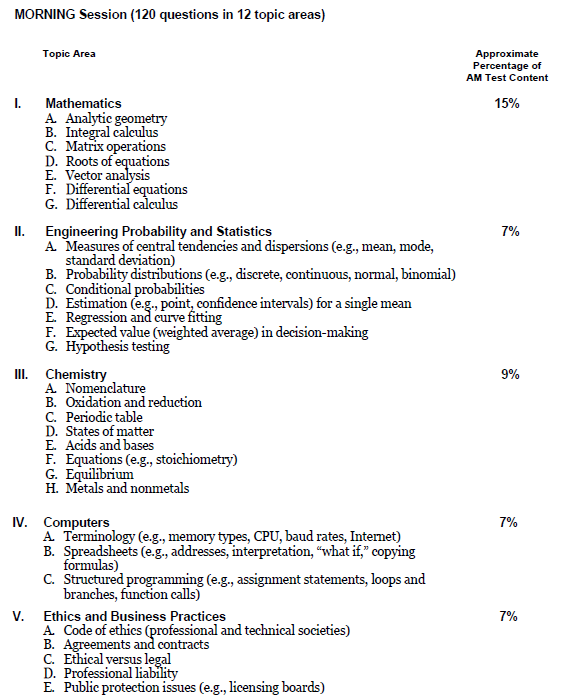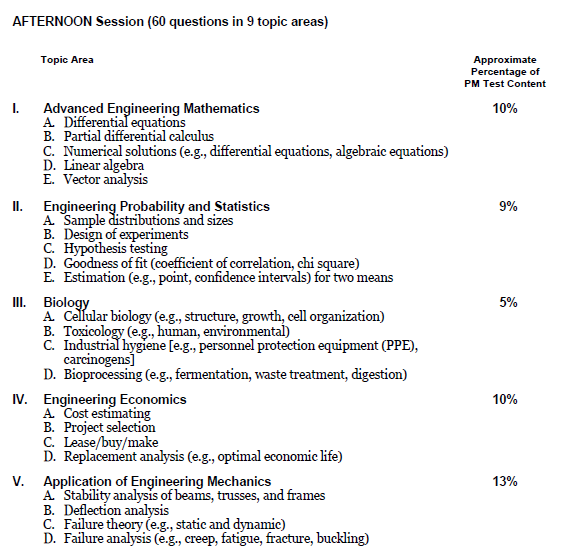We all start here

Every single one of your peers you look up to, every engineering hero you have started where you are right now.
“I don’t think I know enough.”
You don’t know enough about Engineering. Or Math. Or Electrical Circuits. Or Mechanics of Materials. Or you can’t figure out how to solve a Second Order Non Homogeneous Differential Equation.
It feels like there are a ton of moving pieces, and you have to know everything about all of them before you can move forward with taking on the Engineer In Training Exam.
Real successful Engineers know that’s a lie
It’s not that you don’t need to know about Statics and Dynamics.
You do need some background in all these subjects (but we didn’t spend four years in College for no reason).
Once you commit to taking the exam, these areas of knowledge begin to percolate as you spend more time in review, but don’t think you need to know everything, or have been exposed to everything before you decide it’s time to mail that exam application in.
It’s not about what you can recall at this moment, but what you will be able to recall after successfully completing the journey, and the rich opportunities that will naturally seep from it.
I preach taking the journey of becoming a Professional Engineer head on because it’s relatively inexpensive (pennies compared to what it could potentially bring you), because it opens up abundant career opportunities, and because most engineering graduates can do it, and do it NOW!
Learning the art of “just enough”
You could go out and get a PhD in engineering, or whatever you want, and you still wouldn’t be an expert.
You’re never going to learn everything. You’re never going to master everything.
But every successful engineer, heck every successful person, knows the art of “just enough”.
Like almost everything else in life, you’ll get most of your results from just a few key actions (Pareto’s Law). Learn those actions, refine the use of them, and you’re golden.
Can you spend the rest of your career perfecting your discipline? Can you add refinement after refinement to keep growing beyond your original goals?
Absolutely. Lots of people do. But here’s the deal…you have to get moving first.
You need a Roadmap
I realized when building my website out, that I had a ton of information in there (nearly 250 pages and over 9 hours of videos, and rapidly growing), it could be really intimidating to know the simple answer to where to start in preparing for the exam.
So I sketched a quick Roadmap for you in the EIT Preparation Boot Camp. I outlined a detailed, yet simple overview of the process of becoming a registered engineer, the mindset it takes, and how to get yourself organized and ready to execute.
The study schedule I summarize within takes a huge overwhelming task in preparing for the Engineer in Training exam and breaks it down in to a manageable set of stepping stones. Breaking the process down in to something that I could wrap my head around is how I was able to set myself up for success on my journey, and precisely how I got moving.
Successfully preparing for this exam is done one step at a time. If you never get moving, you’ll definitely never get there.
You need a “Quick Win”
Whenever we start on a journey, regardless of what it is, we need to establish a Quick Win to help build our morale and give us a sense of achievement and enhanced momentum towards our ultimate goal.
But where can we find that quick win when it comes to preparing for the Engineer in Training Exam?
I can suggest one area to consider.
Take a quick look at the specifications of the exam, specifically the breakdown of each topic and its proportion within the exam; which topics initially stand out the most.
Here are the first 5 subject areas of the AM exam as well as the proportion for each:

And so on…
Well, right off the bat, we are looking at 45% of the AM exam, 22% of which is straight Math.
So are you saying that getting math down would be a Quick Win?
Well how many of the other subjects involve Math? Let’s take a look…
The final 55% of the AM exam are the topics of Engineering Economics, Engineering Mechanics, Strength of Materials, Materials Properties, Fluid Mechanics, Electricity and Magnetism, and Thermodynamics.
How many do you feel have elements of Math…I would suggest that 100% have some sort of Math included.
But before we draw any conclusions, let’s take a look at the first 5 subject areas from the “other” PM session of the Engineer In Training Exam, they are:

In looking at 47% of the PM ‘Other’ portion of the exam, chalk it up to another 19% of which is pure Math.
The remaining 53% of the PM exam are the topics of Engineering Materials, Fluids, Electricity and Magnetism, and Thermodynamics and Heat Transfer.
Is Math something that is prevalent in any of these subject areas?
I think we have established where our Quick Win lies, and this would be more than a Quick Win, it would be, proportionally speaking, a “Huge Win”.
But where do you Start? Math is huge, yes, Math can be intimidating, yes, but that’s precisely why I created the EIT Academy Math course.
You need to start small. Very small, one subject at a time, from the basics and build on it until eventually (faster than you may think) you have the subject dominated.
Justin’s law of preparing for the Engineer In Training Exam…
If you can keep focus on this saying this year, you’re going to make a lot more progress than you did in the past…
Do more of what works. Do less of what doesn’t work.
That might seem almost insultingly simple. But we’ve all heard the term K.I.S.S “keep it super simple” will keep you moving forward. The K.I.S.S principle states that most systems work best if they are kept simple rather than made complex, therefore simplicity should be a key goal in your preparation and unnecessary complexity should be avoided. I maintained focus to K.I.S.S in developing the EIT Academy Math course, and as a result, I created an effective yet easy to follow course minus the sleepy flow of a University lecture written in language only understood using a translator.
Do you need some help with K.I.S.S?
Not everyone in this world was made to go at it alone.
With all the many resources out there, accompanied by the endless amount of readily available distractions, I often found myself as a K.I.D (Keeping it Difficult).
If you’re the type of individual who needs the challenge broken down in to a simple, straightforward, and effective way, then I built the EIT Academy Math course for you.
I’ve also priced it as I would had liked other resources to be priced when I was a struggling young engineer; being easily attainable is key focus in my mission.
Learn just enough, the basics, to get moving. Then keep building one step at a time as your progress systematically towards your goal.
You can do this. You’re smart and you’ve got the desire.
You just need a little focus and education, and a partner to help you over the initial overwhelm.
Click Here to get the EIT Academy Math course.
Take Care!
Justin
P.S.
No product is perfect, and no approach works for everyone. If you purchase the EIT Academy Math course and discover it just isn’t your thing, don’t worry.
If you’re not blown away within the first 30 days, just let me know via email and I’ll promptly send you your money back, no questions asked. I am about value here, I am about providing for you, the goal is to help you succeed, and if you don’t feel my products are helping you do that, I fully accept responsibility and make sure you are taken care of.
Stop letting “not knowing enough” be your excuse for not realizing your goals. You’re closer than you think you are.
Remember, the current Pre-Release offer is exclusively for subscribers only and includes a hefty cut on the price for the EIT Academy Math course. This is a limited offering which closes on Thursday, March 29 at 8:00 PM Eastern (U.S.) Time. If you miss the deadline, the course is headed back under wraps until a later date when it’s released to the Public at it’s regular price.
Get Started with the EIT Academy Math course.




